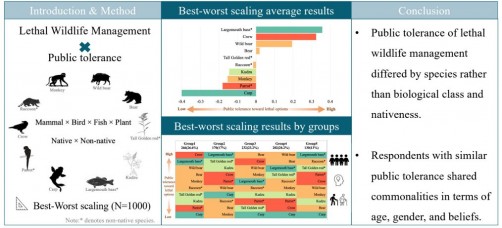Newswise — The escalating human-wildlife conflict (HWC) has raised significant concerns, particularly in the context of biodiversity conservation and sustainable development. To address this issue, lethal management of invasive wildlife species has been deemed necessary to safeguard human lives and livelihoods, despite its controversial nature. However, whether people accept the implementation of such lethal measures remains a critical question. To shed light on this matter and guide future wildlife management practices, researchers conducted a survey to gauge public opinions on the subject.
Their study, published in the Journal of Environmental Management on July 6, 2023, focused on Japan, where there has been a notable increase in wildlife distribution, farmland abandonment, and reduced human activities, leading to a rise in the number of wildlife species. For instance, the wild boar population surged by 252% from 1989 to 2017, growing from 250,000 to 880,000. Unfortunately, this surge in wildlife populations has resulted in increased competition for natural resources and agricultural damage, leading to HWC, which poses challenges to sustainable development and causes social concern. To address HWC, wildlife management strategies are essential, but they often involve lethal measures for the species causing damage, making it a sensitive and contentious topic.
While lethal wildlife management (LWM) can sometimes be more effective in managing damage-causing species than non-lethal methods, it can also trigger public controversy. As a result, understanding public perceptions and attitudes towards LWM is vital for effectively managing the HWC issue. However, there is a lack of comprehensive understanding regarding the level of acceptance of LWM.
To address these uncertainties, a group of researchers, led by Dr. Tomoko Imoto, an associate professor at Tohoku University's Graduate School of Agricultural Science, undertook a study to answer pertinent questions. The researchers aimed to explore how tolerant people are of LWM and whether their attitudes vary depending on the specific wildlife species involved. Additionally, they sought to identify if these attitudes differ across various sociodemographic groups.
By uncovering the public's views on lethal wildlife management, this research can contribute to shaping efficient and sensitive wildlife management strategies that address the human-wildlife conflict and promote biodiversity conservation and sustainable development.
Dr. Imoto, the corresponding author of the paper, explained the rationale behind the study, stating, "Although previous studies have explored public tolerance towards specific wildlife targets, there has been a lack of investigation into variations in tolerance based on wildlife characteristics, such as biological class and nativeness to Japan. To address this gap, we conducted an online questionnaire survey to assess the comparative tolerance of lethal wildlife management (LWM) for ten Japanese wildlife species, including mammals, birds, fish, and plants."
To evoke survey responses, the researchers employed a best-worst (B-W) scaling approach. In this method, respondents were asked to indicate the species they deemed most acceptable (the best) or least acceptable (the worst) to manage lethally for a particular question.
The survey garnered 1,000 responses, leading to various valuable insights. The acceptability of LWM among the public indeed varied depending on the species. Among the ten species studied, largemouth basses were perceived as the most acceptable for LWM, closely followed by crows and wild boars. Conversely, carp, parrots, and monkeys were most frequently chosen as the least acceptable species for lethal management.
Additionally, the researchers examined the harm that people experienced due to wildlife interactions. Crows, wild boars, and monkeys were identified as the most harmful animals, while parrots, carp, and kudzu were considered the least harmful. Interestingly, the study revealed no direct correlations between harm experiences, species' biological characteristics, and their nativeness to Japan.
Furthermore, the researchers noticed that people were more accepting of LWM for species whose negative impact and damage were more likely to be encountered in their daily lives. This suggests that public acceptance of LWM was influenced by the extent to which a species affected their day-to-day activities and well-being.
Through a cluster analysis of the data, the researchers identified that individuals within the same age groups, gender, and those sharing similar beliefs regarding human-wildlife interactions tended to exhibit a common attitude or perspective towards lethal wildlife management (LWM). This finding suggests that shared sociodemographic features play a significant role in shaping people's views on this matter.
In contrast to previous studies, the research revealed that people's attitudes towards LWM were more specific to individual species, rather than being influenced by the species' nativeness to Japan or its broader biological class. This insight highlights the importance of considering species-specific approaches in wildlife management strategies.
The study's sociodemographic findings not only contribute to the existing body of research on the topic but also underscore the significance of involving the public in wildlife management decisions and understanding their opinions and choices. This knowledge can serve as valuable guidance for wildlife managers and policymakers when implementing LWM practices.
Dr. Imoto concludes that future studies should adopt similar research frameworks and methodologies to gain a deeper understanding of the social aspects of wildlife management. This knowledge can ultimately lead to more effective and efficient wildlife management policies, enhance conservation efforts, promote sustainable development, and reduce human-wildlife conflicts worldwide.
MEDIA CONTACT
Register for reporter access to contact detailsCITATIONS
Journal of Environmental Management
